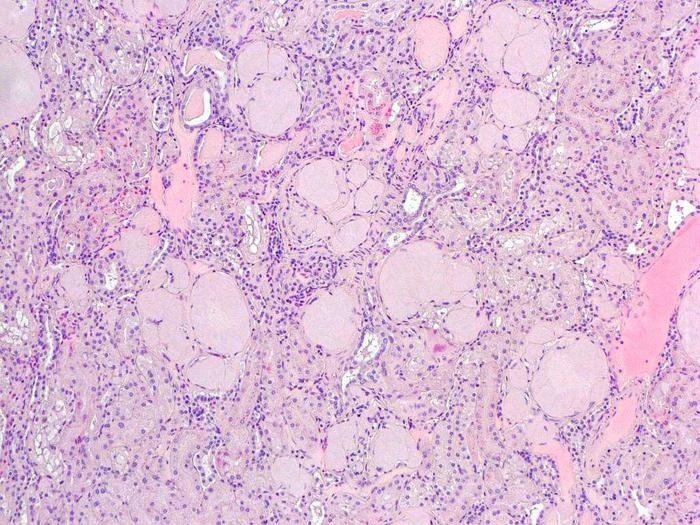Reviewed by Danielle Ellis, B.Sc.Aug 21 2023
Fibrinogen Aα-chain amyloidosis, a condition previously unknown in animals other than humans, has been shown to be extremely common in Japanese squirrels (Sciurus lis), according to a study conducted by Dr Tomoaki Murakami of the Tokyo University of Agriculture and Technology.
 AMYLOID DEPOSITS IN JAPANESE SQUIRREL’S KIDNEY. Image Credit: Tomoaki Murakami, Tokyo University of Agriculture and Technology
AMYLOID DEPOSITS IN JAPANESE SQUIRREL’S KIDNEY. Image Credit: Tomoaki Murakami, Tokyo University of Agriculture and Technology
The pathology was compared to that of humans in this study, and it was suggested that Japanese squirrels were significant in the comparative pathological examination of fibrinogen Aα-chain amyloidosis.
On August 8th, 2023, the researchers published their findings in the Journal of Pathology.
The disease group known as amyloidosis is characterized by the deposition of amyloid in many organs, which is caused by host protein misfolding. Fibrinogen Aα-chain amyloidosis is a hereditary condition in which the protein fibrinogen Aα-chain, which is essential for blood clotting, develops an amyloid form and accumulates in the renal glomeruli, leading to renal failure.
The disease was initially described in 1993, but because there are so few patients and so many questions regarding its pathogenesis, no definite cure has yet been found. In this investigation, they discovered that fibrinogen Aα-chain amyloidosis strikes Japanese squirrels rather often and they compared the pathophysiology of the disease to that of human disease.
The research team found that 29 cases (76.3%) had suffered systemic amyloidosis, which is characterized by severe glomerular amyloid deposition, after first performing histopathological analysis on the whole-body organs of a total of 38 captive Japanese squirrels that died at five zoos in Japan between 2018 and 2022.
I was amazed because it is rare to see such a high incidence of amyloidosis in one animal species.”
Susumu Iwaide, Study First Author and Graduate Student, Laboratory of Veterinary Toxicology, Tokyo University of Agriculture and Technology
They used mass spectrometry to analyze proteomic data and immunohistochemistry to identify fibrinogen Aα-chain as a precursor protein.
Iwaide added, “Interestingly, amyloid exclusively deposited in the glomeruli but not in the tubulointerstitium in the affected kidney, which is same as the human condition.”
Using mass spectrometry, researchers discovered that around 100 amino acids in the C-terminal region of the fibrinogen Aα-chain aggregate in amyloid deposits, which corresponds to human disease. Gene analysis found no differences in the amyloid-forming area between squirrels with and without amyloidosis. There was a statistically significant link between the development of amyloidosis and age.
Furthermore, some of those impacted were direct offspring of wild-protected squirrels.
“We concluded that the reduced genetic diversity due to breeding in the zoo does not cause fibrinogen Aα-chain amyloidosis in Japanese squirrels, but an age-related disease inherent to the species,” Iwaide further noted.
Mutations in the gene of the amyloid-forming region in patients with human fibrinogen Aα-chain amyloidosis result in a change in the amino acid sequence. This suggests that the amino acid sequence of the fibrinogen Aα-chain’s C-terminal region is critical for protein stability.
Given that the pattern of amyloid deposition in Japanese squirrel kidneys was identical to that of human disease, fibrinogen Aα-chain appears to have a common mechanism of amyloid production across animal species.
“The study of animal diseases is important not only for maintaining the health of wildlife and pets, but also for a better understanding of human pathology. Since fibrinogen Aα-chain amyloidosis in Japanese squirrels occurs at a very high frequency, we want to elucidate why Japanese squirrels are susceptible to fibrinogen Aα-chain amyloidosis in detail to develop treatments for the incurable human disease, as well as to maintain the health of Japanese squirrels,” Iwaide concluded.
Source:
Journal reference:
Iwaide, S., et al. (2023). Fibrinogen Aα-chain amyloidosis outbreaks in Japanese squirrels (Sciurus lis): a potential disease model. Journal of Pathology. doi.org/10.1002/path.6150